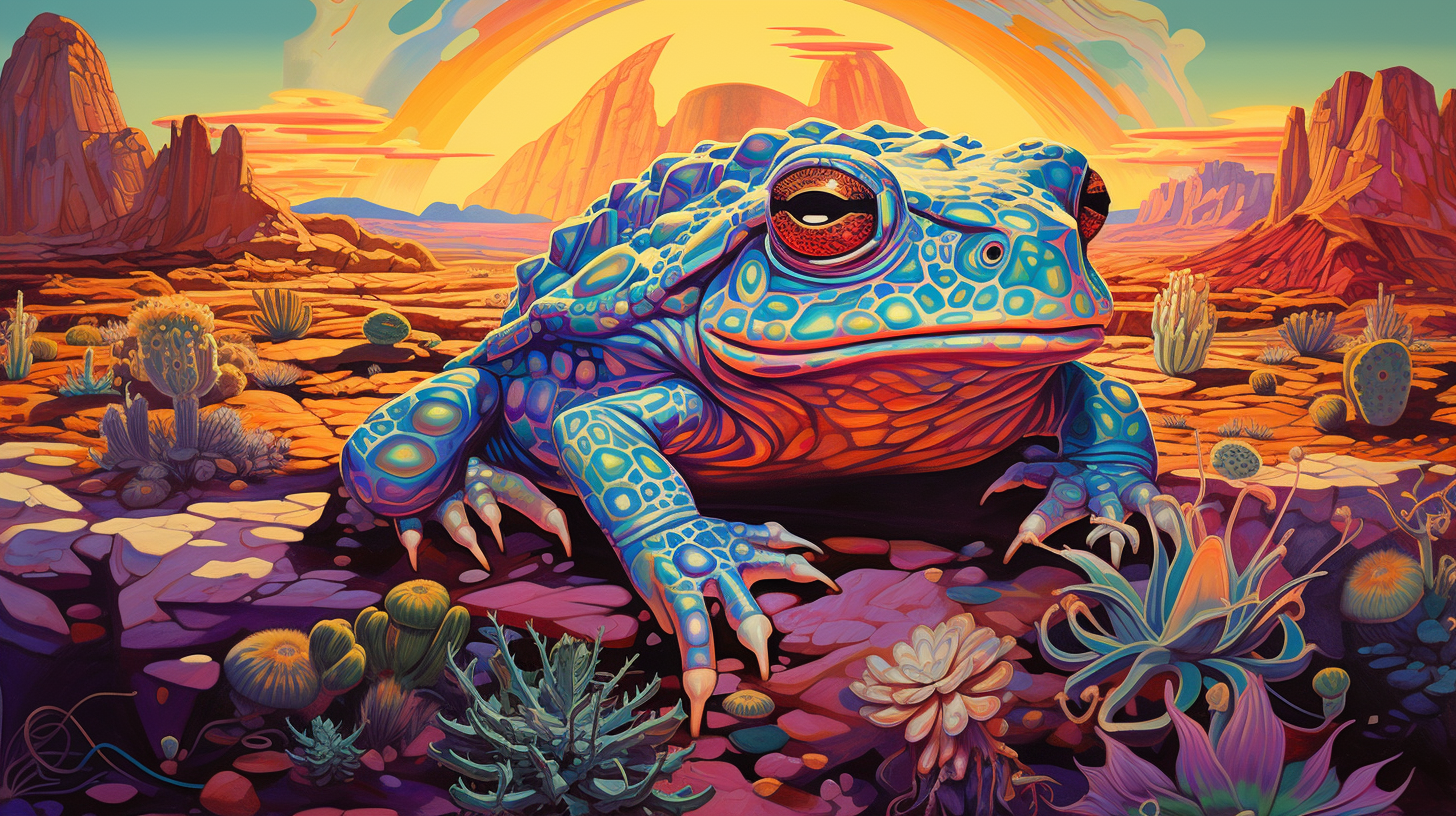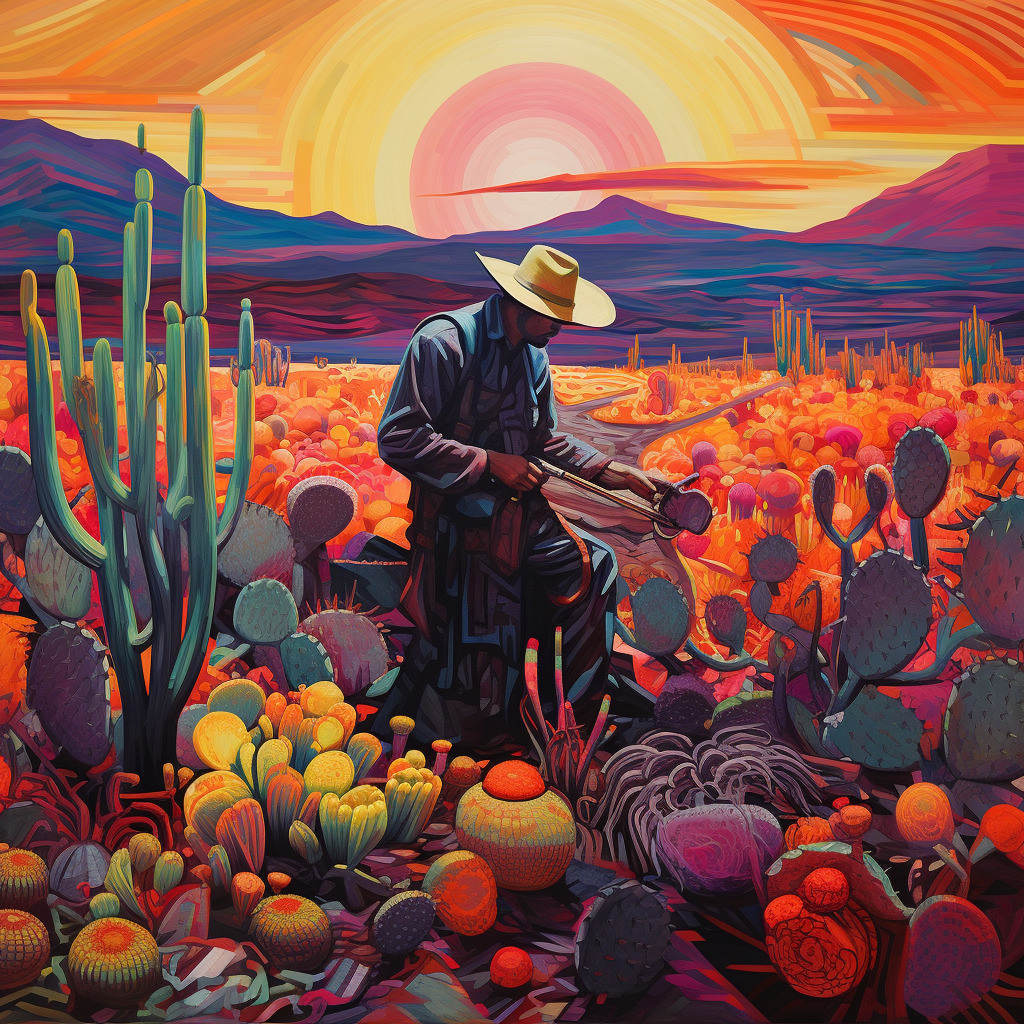We're in Beta 🙃
In the dim light of the Sonoran desert, figures maneuver with flashlights in hand, their eyes set on a prize that's as dangerous as it is lucrative. They are seeking the bufo alvarius toad, a creature that secretes 5-MeO-DMT, a substance so profound it's earned the moniker "the God molecule."
Once obscure, this powerful psychedelic now ignites not just transcendental experiences but also controversial debates.
Understanding why individuals risk their livelihoods for toad venom calls for an examination of its two-fold appeal: the promise of a deep psychological metamorphosis and the practical allure of financial gain.
However, this hunt is anything but straightforward. Alongside the prospects of a spiritual awakening and economic stability lurk the dangers of cartel involvement and environmental disruption.
The dichotomy of this pursuit—its capability to heal and to harm—involves a complex tapestry of psychedelics, neuroscience, and socio-economic issues.
The Allure and Perils of Toad Venom Harvesting

Harvesters armed with knowledge and nets trudge through nocturnal landscapes to milk the glands of toads, a process transforming venom into a commodity, and in turn, a good night’s work into a substantial paycheck.
Their monthly take-home pay may average around £1,400, but not without the cartels claiming their cut. Harvesters walk a tightrope between satiating the global demand for this sublime experience and navigating the treacherous terrain of organized crime.
The importance of toad venom transcends its role in individual journeys; it also casts a light on the broader canvas of human endeavor.
Embracing the phenomenon of toad venom is about understanding a socio-economic and environmental dilemma—a local resource under siege, a community caught in cartel crossfires, and the ethical complexities of ancient rituals reborn as modern treatments.
The Impact of Psychedelics on Self-Development and Popular Culture
Psychedelics like 5-MeO-DMT weave an intriguing narrative, bridging ancient rites to modern enlightenment, and nowhere is this narrative more enlivened than in its endorsement by high-profile figures.
Notables such as Hunter Biden, Mike Tyson, Eric Andre, and Joe Rogan have all shared their transformative experiences with the world, bringing the potent effects of toad venom from the shadows of counterculture into the blinding light of mainstream media.
These testimonials stand as beacons to those seeking alternative pathways for self-development, guiding them toward experiences that proponents describe as ego-dissolving journeys to oneness.
This wave of publicity has sent ripples through popular culture, inspiring curiosity and acceptance but also stirring controversy over safety, accessibility, and the morality of commodifying such a potent substance.
The debate intensifies with each public revelation, yet it's clear that 5-MeO-DMT is now a formidable cultural force, shaping not only individual destinies but also the broader discourse on consciousness and healing.
The stories of high-profile transformations propel this psychedelic substance further into the cultural lexicon, solidifying its significance not only in self-development cycles but also within the fabric of societal evolution.
The esteem in which public figures hold toad venom underscores a widespread hunger for transformative experiences and aligns with a growing body of research advocating psychedelic therapy.
But even as the stories of celebrities grab headlines, beneath the surface lies a pressing narrative: the intricate tapestry of supply and demand, indigenous rights, and environmental stewardship.
Each tale of a life altered by the toad's potent kiss adds a thread to the complex weave of modern society's approach to psychedelics—a realm where science and spirituality, commerce and conservation intermingle.
The Dark Intersection of Cartels and Psychedelic Commerce
The toad venom trade ensnares collectors in a web of cartel politics, casting a dark shadow over this natural wonder. Harvesters find themselves at the mercy of territorial battles not of their own making, where the fruits of their labor enrich the pockets of crime lords as much as their own.
The deserts of Sonora, rich in biodiversity, have become contested grounds where the quest for 5-MeO-DMT is inseparable from the sway of organized crime.

Navigating these perilous landscapes requires a level of acumen that goes beyond knowing the toads' habits. Harvesters must judge the risk of stumbling into a trafficking route against the possible rewards of a successful night’s collection.
Cartel factions, once locked in a power struggle, now dictate who can harvest and at what cost. Notable stories are emerging of harrowing abduction and coerced labor, serving as a stark reminder of the human cost that underscores this lucrative trade and the psychedelic experiences it offers.
The Shifting Economics of Toad Venom Amidst Cartel Domination
The economics of the toad venom trade in Hermosillo reflect a harsh reality: cartels don't just influence prices; they dictate them. With meth addicts now joining the ranks of collectors, an increased supply has driven down the cost of venom locally.
Once a lucrative business, the trade now suffers from a double-edged sword—a flooded market that diminishes individual profit while feeding cartel dominance.
As the price for a gram of venom plunges in Hermosillo, consequent effects ripple through the community. A collector we'llc call José, for example, struggles to maintain the value of his harvest despite the market's downturn.
The cartels capitalize on this desperation, tightening their grip on an already volatile trade. The shift is palpable, mirroring the greater dynamics of power and economic distress that characterize the region.
Moreover, the influx of collectors with substance dependencies complicates the supply chain, altering the purity and ethics of the trade.
Joel Brierre of F.I.V.E. observes the troubling signs of this transformation: contamination with carbon and other adulterants tarnishing the venom’s quality.
What was once a straightforward transaction now harbors deceit, as scarcity prompts unscrupulous practices.
The irony of toad venom as a means of economic sustenance amidst poverty cannot be overstated. The potential for prosperity exists, yet it teeters on the brink of exploitation and environmental disregard.
The very thing offering a way out for some ensnares them further into a cycle of dependency—not just chemical, but economic. The cycle that sees both cartel and collector ensnared in a mutually destructive embrace casts a long shadow over the toad venom phenomenon, demanding a critical analysis of this complex trade.
Additional Conservation and Ethical Considerations
The need for sustainable practices becomes critical as collectors, enamored by profit, may overlook the impact of their actions on toad populations.
In the Sonoran desert, unregulated harvesting raises alarms among conservationists who argue the need for balance — a way to honor both the demand for spiritual enlightenment and the toads’ ecological role.
Questions of ethical conduct also surface in this arena. Robert Villa, a herpetologist, paints a picture where conservationism clashes with the raw need of those dependent on this trade. With toads often not returned to their habitats, the desert faces a potential ecological imbalance.
Amidst these ecological quandaries, the community grapples with the moral implications of sourcing and utilizing toad venom. Can traditions and modernity coexist without one exploiting the other?
The tribal ceremonies utilizing the substance for healing suggest a path of respect and sustainability, while the increasing use by outsiders spotlights a cultural appropriation debate.
Striking a harmonious relationship with nature, while acknowledging the past and nurturing the present, demands thoughtfulness from practitioners and participants alike.
The dialogue around conservation and responsible use not only frames the future of 5-MeO-DMT but also reflects our larger commitment to preserving biodiversity and respecting indigenous heritage.

